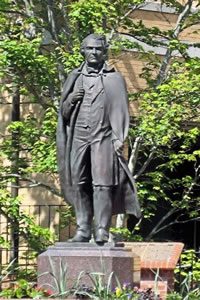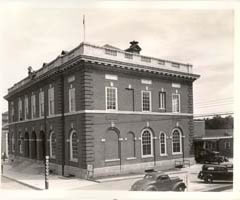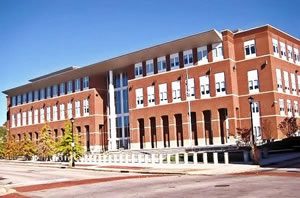LOCATION AND SIZE
Greene County is located in the southwest portion of Northeast Tennessee with a total area of 624.11 square miles, which includes 621.69 square miles of land area and 2.42 square miles of inland water area, as shown in illustration 1. Also a part of the Cherokee National Forest, 38,523 acres, or 60.19 square miles, is located in the southern portion of Greene County. Neighboring counties include Madison County in North Carolina bordering to the south; while in Tennessee, Washington and Unicoi Counties border to the east; Hawkins County borders to the north; and Hamblen and Cocke Counties border to the west.
Greeneville, the county seat for Greene County, is Tennessee’s second oldest incorporated town. It is located south of Interstate 81 and within 40 miles of Interstates 26 and 40, and 75 miles of Interstate 75. It is also served by U.S. Highways lIE and 321, and State Routes 34, 70, 93, 107, and 172.
HISTORICAL SUMMARY
Settlement first began in 1772 when Jacob Brown and others relocated from North Carolina and established a camp on the banks of the Nolichucky River. Three years later a large tract of land was leased from the Cherokees by Mr. Brown, and titled as part of the North Carolina’s Washington District. In 1777 a Swiss immigrant, Henry Earnest, established Elmwood Farm alongside the Nolichucky River, establishing it as one of the oldest documented Tennessee Century Farms. The desire for a separate government grew with the increasing number of settlers to the area Through the efforts of Daniel Kennedy and Waightstill Avery, Greene County was formed in 1783 through a division from Washington County. The County is named in honor of Nathanael Greene, Revolutionary War Commander.
In 1784 Greene County, Washington County, Sullivan County and the Western territories of North Carolina all participated in the creation of the State of Franklin. Greeneville was designated as the capital. During this period the people had divided loyalties and operated with two sets of government officials, North Carolina’s and the State of Franklin’s. During the 1785 constitutional convention held in Greeneville, split participation was evident and contributed to the collapse of the State of Franklin in 1788. In 1789 North Carolina ceded its western lands including Greene, Sullivan and Washington counties to the Federal Government. Congress designated this area as part of the Territory of the United States and on June 1, 17% of Tennessee was admitted to the Union as the 16th state.
Religion played an important role in Greene County’s early educational history. Presbyterian minister, Dr. Samuel Doak, received a charter for a private academy, which became Washington College in 1795. The Greeneville College, established in 1794 by Hezekiah Balch, was the first college west of the Alleghenies. In 1818 Dr. Samuel Doak resigned as president of Washington College and along with his son established another school, Tusculum College. Tusculum and Greenville Colleges merged to become what is known today as Tusculum College. Greene County also marked the emergence for other religions in Tennessee. The Ebenezer Church, established in 1792 by the Earnest family, was associated with founding Methodism in Tennessee. Also, in 1795, New Hope Quaker Meeting occurred near Ripley Creek.
During the Civil War Greene County was largely Unionist. In 1861, during the weeks immediately preceding the Civil War, the State’s largest and most important pro-union meeting occurred at the Greeneville Convention. Greeneville became the winter quarters for General James Longstreet following the Confederate disaster at the Battle of Knoxville in 1863. Confederate Calvary Commander John Hunt Morgan died in September, 1864 in Greeneville, when a Union force commanded by Alvan C. Gillem surprised him and his officers.
On the lawn of the Greene County Courthouse are two monuments that commemorate the Civil War. One is dedicated to local troops who served in the Grand Army of the Republic (Union), and another memorializes General Morgan, known as the ‘Thunderbolt of the Confederacy.” Greeneville is thought to be the only town in the United States that pays tribute to both the Union and the Confederacy in its courthouse square.
 One of Greene County’s most famous citizens, Andrew Johnson, moved from North Carolina to Greeneville in 1826, and set up a tailor’s shop. In 1829 he was chosen as alderman and in 1834 he became Greeneville’s mayor. During the next 30 years he served in both the Tennessee and United States legislatures.
One of Greene County’s most famous citizens, Andrew Johnson, moved from North Carolina to Greeneville in 1826, and set up a tailor’s shop. In 1829 he was chosen as alderman and in 1834 he became Greeneville’s mayor. During the next 30 years he served in both the Tennessee and United States legislatures.
After Abraham Lincoln’s assassination in 1865, Vice President Andrew Johnson then became the 17th President of the United States. His home and tailor shop, as well as a visitor center, and a national cemetery where he is buried, are open to the public and maintained as a National Historic Site by the U.S. Park Service. During the Civil War, Greeneville changed hands numerous times. Although the state as a whole had voted to secede, East Tennessee was an island of predominately Unionist sentiment in the South.
UNITED STATES COURTHOUSE
 In 1903 the comer of Summer Street and Main Street became the location for one of only 15 federal courthouses to be built in the early 1900’s. It took two years to complete and the new building officially opened in June, 1905. It served as both federal courthouse and post office until 1983 when the post office moved to its new location on West Summer Street.
In 1903 the comer of Summer Street and Main Street became the location for one of only 15 federal courthouses to be built in the early 1900’s. It took two years to complete and the new building officially opened in June, 1905. It served as both federal courthouse and post office until 1983 when the post office moved to its new location on West Summer Street.
In September 2001 a new federal Major Events Affecting Development courthouse was constructed at the comer of West Depot Street and North Irish Street. It was  renamed the James H. Quillen U.S. Courthouse. The former courthouse served the 10 county Northeastern District for nearly 100 years and is listed on the National Register of Historic Places.
renamed the James H. Quillen U.S. Courthouse. The former courthouse served the 10 county Northeastern District for nearly 100 years and is listed on the National Register of Historic Places.
MAJOR EVENTS AFFECTING DEVELOPMENT
The early economy of the area was made up almost totally of agriculturally oriented activities. However, following World War II, numerous non-agricultural activities became part of the local economy as a number of manufacturing firms located in and around Greeneville. This input helped provide additional employment opportunities and relieved the declining agricultural economy by providing a means of livelihood for a growing number of people. Although agricultural activities still play a major role in the area, a better balance in the economy has been achieved.
EARLY SETTLEMENTS GREENE COUNTY
The fIrst settlements were made in Greene County around 1778 along the Nolichucky River and Lick Creek. Greene County was formed in 1783 from a part of Washington County. The early settlers came from North Carolina, Virginia and the Atlantic Seaboard.
The early economy of the county was almost totally made up of agricultural activities. Most of the products, however, remained in local markets with only small amounts of products being shipped across the mountains to the Eastern Seaboard. The construction of the railroad through East Tennessee in the middle 1800’s provided the region with access to outside markets for the products of the economy. Greeneville developed into the marketing center of Greene County, due to the central location within the county. In 1885 a tobacco market was established in Greeneville to handle the sale of burley tobacco that had become a major crop in Upper East Tennessee. This led to the establishment of Greeneville as one of the leading burley tobacco markets in the nation. The small number of manufacturing activities in Greeneville were linked directly to agricultural activities and fluctuated with basic agriculture cycles.
After World War II, the location of a number of manufacturing activities in and around Greeneville started a process that would eventually change the economy of the county. Manufacturing jobs increased and agricultural employment decreased. Recently, traditional manufacturing activities such as furniture, wood products and electronics have declined or noted slow growth. Other industries new to the region such as chemicals, fabricated metals, transportation and distribution, and machinery have experienced gains. Recently there has been an increase in the service sector of the economy. This economic growth has offset employment declines in agriculture and manufacturing, and provided a rise in personal income for Greene County residents. The county has developed a diversified modem economy that is not dependent on any one industry.
THE TOWN OF GREENEVILLE INCORPORATED IN 1903
Greeneville was first begun as a 300-acre tract of land owned by Robert Kerr. The land, was located at the Big Spring. Greeneville was first established by Charter as a town and as the County Seat of Greene County in 1783. The Town was officially incorporated in 1903.
The area’s first European settlers were Scots-Irish who came from other areas of the southeastern United States. The town and county were named for Revolutionary War hero General Nathanael Greene of Rhode Island.
Frontiersman Davie Crockett was born in Greene County, near present-day Limestone in 1786. He died in Texas in 1836 defending the Alamo during the war for Texas’ independence from Mexico.
THE TOWN OF BAILEYTON INCORPORATED IN 1915
The Baileyton Community began as a small trading settlement along one of the many pioneer roads that led westward from Snapps Ferry, a river crossing at the south fork of the Holston River in Sullivan County. The Baileyton Community originated on property given by land grant to the Bailey family. The community was located at the intersection of Snapps Ferry Road and the pass through Laurel Gap that led through the Bays Mountain Range into Hawkins County. In the 1870’s and 1880’s Greene County established a number of community colleges for higher education. The Baileyton Seminary was one of the most prominent of these schools and the community began to develop in the 1880’s as a result of the school. The school was founded in 1882 with the help of a group of community civic leaders and was operated as the Oakland Seminary until 1915 when it was bought by the Greene County Board of Education. In 1917, an addition was added to the Old Seminary building, and served as Baileyton High School until a new building was erected in 1938.
The Town of Baileyton was officially incorporated in 1915. The primary purpose for incorporation was to obtain an additional magistrate for the area since state law at the time provided for one additional magistrate for a district if the district had an incorporated town.
In 1928, Tennessee Governor Henry Horton provided for major improvements to the Snapps Ferry Road that was renamed Horton Highway in his honor. Laurel Gap Creek was renamed Gardner Creek. The town continued to survive as a sleepy farming community that provided a school and churches, bank and post office, and a limited number of stores and service stations for the people in northern Greene County.
In 1974, Interstate 81 was completed through Greene County and an interchange was located at Baileyton. The interstate and an improved road from Baileyton to Greeneville brought commercial development and land speculators and the increasing need for a sanitary sewer system to accommodate the existing and anticipated development. The sewer system was completed in 1988.
The Town of Baileyton has had a slow steady growth. In 1940 the town had a population of 229 persons. By 1980 the population had increased to 333 persons. The 1998 certified population for Baileyton was 406 persons. Even though Baileyton has not had tremendous residential growth the town has experienced significant growth in the commercial sector.
THE CITY OF TUSCULUM INCORPORATED 1959
The City of Tusculum is located in Central Greene County adjacent to the much larger Town of Greeneville, Tennessee. The city developed around Tusculum College which was established in 1818 by Reverend Samuel Doak. The college is still the mainstay of the community along with Greene Valley Development Center which located in Tusculum in the early 1960’s. Although Tusculum was a thriving community for many years, it didn’t incorporate as a city until May 12, 1959.
THE TOWN OF MOSHEIM INCORPORATED 1974
Mosheim owes its origin to two factors of geography, the large spring of blue water close beside the pioneer wagon road through Greene County, plus the fact that the spring was located near midpoint between Greeneville and Bulls Gap on the early thoroughfare.
The blue spring attracted special attention due to its reflection of the sky. So marked was the reflection that the village, now known as Mosheim, early assumed the name “Blue Spring”. As the midpoint between the two early towns, it was inevitable that with the advent of the stage coach Blue Spring would be a main stopping point.
The village offered the Swamp Hotel, eating establishments, shops and trading posts for the many travelers. In 1858, the Virginia-East Tennessee Rail Line came directly through the young village. Along with growth and prosperity the railroad also brought tragedy and destruction to the area in the form of the Civil War. As the most important rail line in the south at the time, the Virginia-East Tennessee Rail Line was the focus of much attention and fighting throughout the conflict. Although there were frequent skirmishes, only one developed into a full scale battle named The Battle of Blue Springs. Fought on October 10, 1863, the battle lasted about nine hours and involved thousands of troops, ending with the Confederates being driven into Virginia, never to return to capture East Tennessee.
In 1896 the village was known for being an educational and cultural center for two postwar social developments, an institution of higher learning, and the development of that school into a college.
The initial school was the product of a determined effort by enterprising local citizens; its development into a recognized college was the result of sustained dedication by the Lutheran Church, which purchased the school property soon after its establishment. The “Old College”, a substantial two-story brick building erected about 1870, stood north of the big spring. Soon after the property was purchased it was named after a renowned German theologian, Johann Lorenz von Mosheim. The Mosheim College was so successful the village assumed that name as well.
In 1913 Mosheim College property was purchased by the Greene County Board of Education for the establishment of a public four-year high school. In 1924 the old college buildings burned and were replaced immediately by a large brick building on the original foundation. For several years Mosheim High School was the only Grade A high school in Greene County. It continued to be so for several decades and was the largest rural school in the county. In 1966 it was consolidated, forming a new school which is called ”West Greene” High School.
Used with Permission.
Greene County Land Use and Transportation Policy Plan – August, 2009
